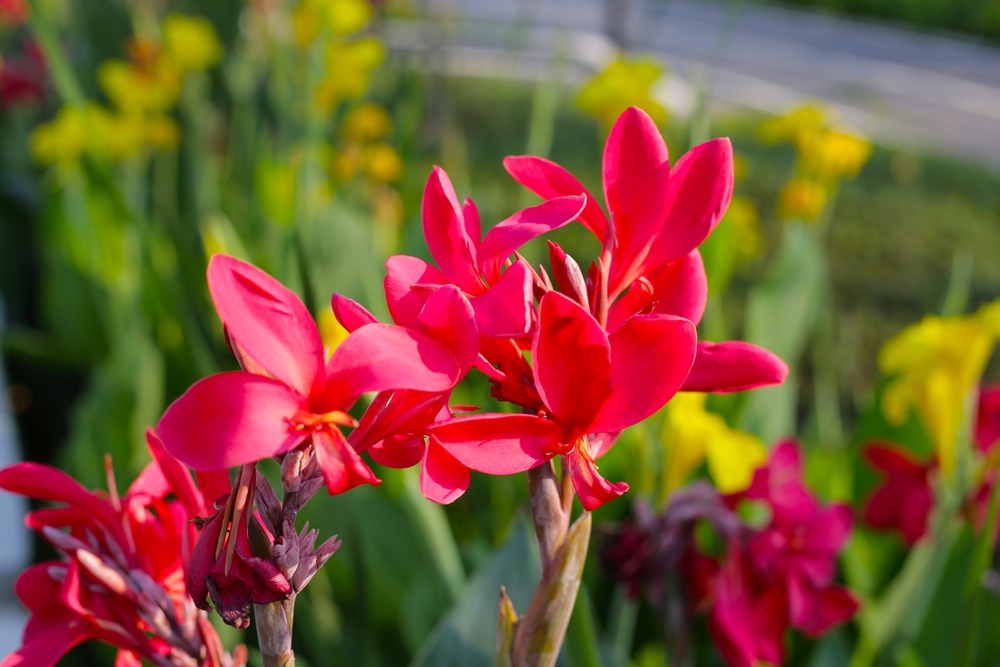
Image Source: Shutterstock.com
One minute, your garden looks like a late-summer dream come alive, with dahlias shining like jeweled fireworks and cannas standing tall like confident tropical dancers. Then, almost overnight, a cold snap slides in, the air turns sharp, and suddenly everything you love could collapse into soft, disappointing mush.
Gardeners know this heartbreak deeply. The colors and textures of dahlias and cannas seem invincible in warm weather, yet frost takes no mercy and no prisoners. The good news is that, with a little timing, some careful digging, and the right storage approach, you can rescue these beauties and bring them back strong next year.
Know When Frost Is Coming
Frost timing is everything, and your flowers are depending on your ability to pay attention to the forecast. The moment temperatures start dipping near freezing, your dahlias and cannas begin to cross into danger territory. Checking local frost charts helps, but nothing beats watching your own nighttime lows as the season shifts. A sudden early frost can surprise gardeners, but even a light frost can start damaging foliage fast. The key is to act before a hard freeze leaves the plants too mushy to handle cleanly.
Let Them Enjoy The Last Warm Days
You actually do not want to dig your tubers too early because they are still storing energy for next year’s blooms. Letting the plants continue growing until just before frost helps the roots mature and strengthen. Watch the foliage closely, because you want to harvest when the flowers are fading but before the plant becomes fully frost-bitten and limp.
If you have time before frost night, stop watering to encourage the plant to concentrate on building energy storage. This little stretch of patience is what turns next summer’s flowers from good to spectacular.
Cut Back The Foliage
Once frost has kissed the leaves or once you are ready to dig, the first step is to cut the plants down. The stems can be trimmed to about six inches from the ground, so you have something easy to hold onto. Do not worry about being overly delicate during this step; the critical part is still underground. Removing the foliage makes digging easier, cleaner, and far less messy. It also helps prevent rot by removing plant tissue that is likely to decay quickly.
Dig Up The Tubers Carefully
Dahlias and cannas both grow from underground storage structures, but they are slightly different in shape and handling. Dahlias have clusters of tubers that resemble elongated teardrops, while cannas have thick rhizomes with a more root-like form. Use a garden fork instead of a shovel to avoid slicing right into the tubers below. Start digging several inches out from the stem and gradually loosen the surrounding soil. When you lift the clump, go slowly and let the soil fall away naturally to avoid breaking the tubers apart prematurely.
Clean And Dry Them Fully
Once the tubers or rhizomes are removed, shake or brush away loose soil without washing them yet. Washing introduces moisture that can create mold or rot during storage if you are not careful. Set the tubers on a tray, cardboard sheet, or even newspaper in a warm, airy location where they can dry for a few days. This curing period lets the outer skin toughen and small wounds heal over. Only after they are dry should you gently remove the remaining soil and discard any parts that are rotted or soft.

Image Source: Shutterstock.com
Label Before You Forget
This step is where many gardeners accidentally create their own springtime mysteries. While the flowers are unforgettable when blooming, the tubers all look suspiciously similar once they are cleaned up. Grab a marker or tag and label each clump with its variety, color, or at least the plant type. In the future, you will be incredibly grateful for this tiny act of organization. It saves guesswork, disappointed expectations, and very dramatic identity crises in May.
Store In A Cool, Dry Place
Tubers need a storage environment that mimics winter dormancy: cool but not freezing, dark but not damp. A basement, garage, or insulated shed often works well as long as temperatures stay above freezing and humidity remains reasonably low. Many gardeners pack their tubers in peat moss, wood shavings, or shredded newspaper to cushion them and regulate moisture. Check them monthly throughout winter to make sure none are shriveling or rotting. Tubers are living structures and appreciate occasional attention, much like forgotten houseplants.
Reawaken Them In Spring
When warm weather returns, it is time to bring your dahlias and cannas back into the light. If your springs are long and chilly, you can start them indoors to get a head start. Plant them in pots with loose, well-draining soil and keep them slightly moist until shoots appear.
Once outdoor temperatures are consistently warm, transplant them into the garden and give them space to shine. The reward is watching something you saved surge back to life, better than ever.
The Beauty Is Worth The Effort
Saving dahlias and cannas before frost can feel like a race against nature, but the payoff is tremendous. These plants love to return with even more vigor the second time around, making your garden feel like a celebration of resilience and care. The act of digging, storing, and protecting them turns you from a casual gardener into a keeper of botanical history.
If you have tips, mistakes, questions, or proud success stories, share them in the comments below. Gardeners learn best from each other, and your experience could help someone save their blooms, too.
You May Also Like…
- How Autumn Pollinators Choose Their Flowers
- 10 Flowers to Deadhead for Extra Fall Blooms
- 9 Ways to Turn Fallen Branches Into Garden Supports
- 10 Tools Worth Sharpening Before Winter
- How Early Frosts Shift Plant Chemistry
Leave a Reply